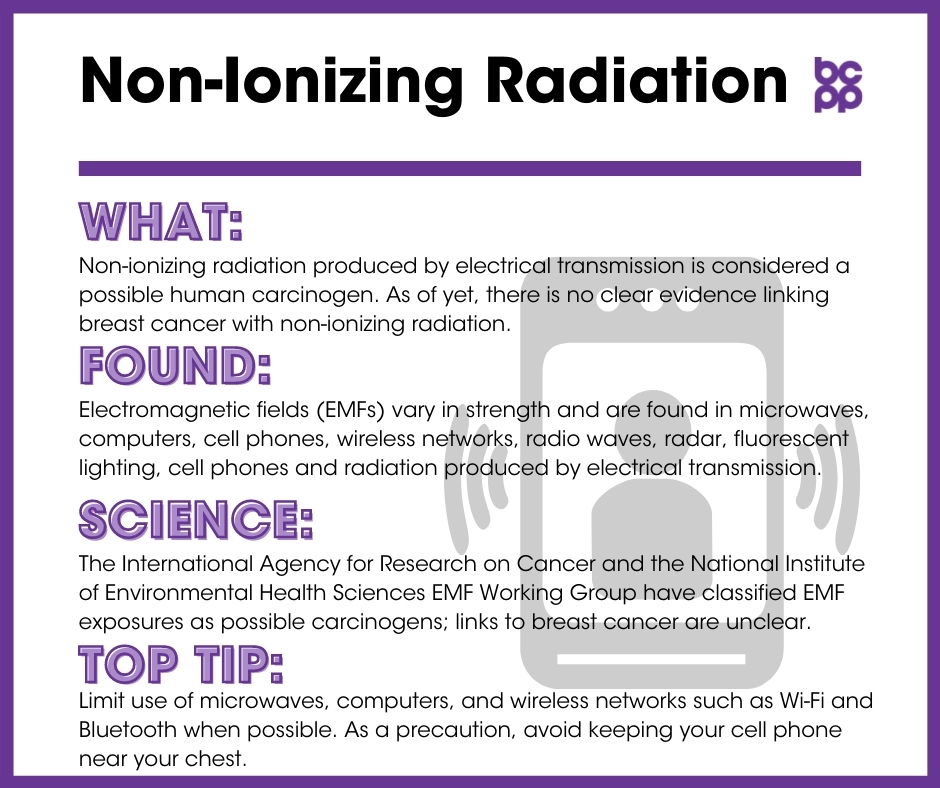Non-Ionizing Radiation (EMFs)
At a Glance
Microwaves, radio waves, fluorescent lighting, computers, cell phones, radar and radiation produced by electrical transmission are examples of non-ionizing radiation sources that generate varying strengths of electromagnetic fields (EMFs). Non-ionizing radiation is considered a possible human carcinogen, primarily due to concerns about childhood leukemia and brain tumors.
As of yet, there is no clear evidence linking breast cancer with non-ionizing radiation.
What is non-ionizing radiation (EMFs)?
EMFs are a type of non-ionizing radiation that emit low-frequency radiation without enough energy to break off electrons from their orbits around atoms and ionize (charge) the atoms.
Where are EMFs (non-ionizing radiation) found?
EMFs vary in strength and are found in microwaves, computers, cell phones, wireless networks, radio waves, radar, fluorescent lighting, cell phones and radiation produced by electrical transmission.
What evidence links EMFs (non-ionizing radiation) to breast cancer?
Both the International Agency for Research on Cancer and the National Institute of Environmental Health Sciences EMF Working Group have classified EMF exposures as possible human carcinogens, primarily due to concerns about childhood leukemia and brain tumors.[1],[2] In contrast, the findings of studies exploring links between EMF and breast cancer, specifically, have varied.[3],[4] Methodological issues may account for some of the discrepancies, given the relatively small effects that are found and the ubiquitous nature of “background” EMF in our daily lives.[5]
- One study reported an increased risk of breast cancer among Norwegian female radio and telegraph operators exposed to EMF. Pre-menopausal women showed an increased risk of estrogen-receptor-positive (ER+) tumors, and post-menopausal women had an increased risk of estrogen-receptor-negative (ER-) tumors.[6]
- In an occupational study that looked at women in job settings with the potential for high, medium or low electromagnetic exposures, high exposures were associated with an increased risk for developing breast cancer. Pre-menopausal women appear to be at higher risk than post-menopausal women.[7]
- Studies of residential and occupational EMF exposure found a significant increase in breast cancer risk among women of all ages living near high-voltage power lines. Similar effects were found for women with ER+ and ER- Occupational exposure also increased risk.[8] Women younger than age 50 who were exposed to EMF both at home and at work had a modest increase in risk of breast cancer.[9]
- A meta-analysis of 15 studies concluded that there is no clear relationship between EMF exposure and breast cancer in women.[10] Another meta-analysis, examining a subset of published studies that specified mode of exposure, reported a small increase in breast cancer rates in pre-menopausal women, associated with increased residential exposure to EMFs.[11]
- Although breast cancer is rare in men, numerous occupational exposure studies point to a connection between EMF exposure and male breast cancer.[12],[13],[14],[15],[16]
- In the laboratory, EMFs can cause increased mammary tumors in animals and proliferation in systems in which human breast cell tumors are grown in culture. Importantly, effects in rodents are found in some strains of animals but not others, indicating that subtle differences in genetic background might make some animals more susceptible to the carcinogenic effects of EMF.[17] In an in vitro cell system, EMF exposure of human breast tumor cells led to an activation of genes that have been associated with the induction of metastasis in breast cancer cells.[18]
Who is most likely to be exposed to EMFs (non-ionizing radiation)?
Research suggests women who have an increased residential or occupational risk are more likely to be exposed to EMFs. However, EMFs are consistently present in our everyday environment, so everyone has some exposure.
Who is most vulnerable to the health effects of EMFs (non-ionizing radiation)?
- There is some evidence that pre-menopausal women may be more vulnerable to EMFs.
What are the top tips to avoid exposure?
Many routes of exposure are seen as unavoidable in our day and age, but practicing these tips may help prevention:
- As a precaution, avoid keeping your cell phone near your chest, and use a wired headset if you use your phone to talk, to limit exposure to your brain.
- Limit use of microwaves, computers and wireless networks such as Wi-Fi and Bluetooth when possible. These items are a constant in our environment, but limiting exposure may be beneficial, especially for children.
- The National Institute of Environmental Health Sciences suggests that if you are concerned about EMF exposure by a power line or substation in your area, you can contact your local power company to schedule an on-site reading.
Reviewed 2019
[2] International Agency for Research on Cancer. “IARC Monographs on the Evaluation of Carcinogenic Risks to Humans Volume 80:
Non-ionizing Radiation, Part 1: Static and Extremely Low-frequency (ELF) Electric and Magnetic Fields.” Lyon, France: IARC Press, 2002. http://monographs.iarc.fr/ENG/Monographs/vol80/mono80-6E.pdf.
[3] McElroy JA et al. “Occupational exposure to electromagnetic field and breast cancer risk in a large, population-based, case-control study in the United States.” Journal of Occupational and Environmental Medicine 49, 3 (2007): 266-274. doi:10.1097/jom.0b013e318032259b.
[4] Peplonska, Beata et al. “Occupation and breast cancer risk in Polish women: a population-based case-control study.” American Journal of Industrial Medicine 50, 2 (2007): 97-111. doi:10.1002/ajim.20420.
[5] Ahlbom, I C et al. “Review of the epidemiologic literature on EMF and Health.” Environmental Health Perspectives 109, 6, 6 (2001): 911-33. doi:10.1289/ehp.109-1240626.
[6] Kliukiene, J et al. “Follow-up of radio and telegraph operators with exposure to electromagnetic fields and risk of breast cancer.” European Journal of Cancer Prevention 12, 4 (2003): 301-7. doi:10.1097/00008469-200308000-00010.
[7] Coogan, P F et al. “Occupational exposure to 60-hertz magnetic fields and risk of breast cancer in women.” Epidemiology 7, 5 (1996): 459-64.
[8] Kliukiene, Jolanta, Tore Tynes and Aage Andersen “Residential and occupational exposures to 50-Hz magnetic fields and breast cancer in women: a population-based study.” American Journal of Epidemiology 159, 9 (2004): 852-61. doi:10.1093/aje/kwh116.
[9] Feychting, M et al. “Magnetic fields and breast cancer in Swedish adults residing near high-voltage power lines.” Epidemiology 9, 4 (1998): 392-7.
[10] Chen, Chunhai et al. “Extremely low-frequency electromagnetic fields exposure and female breast cancer risk: a meta-analysis based on 24,338 cases and 60,628 controls.” Breast Cancer Research and Treatment 123, 2 (2010): 569-76. doi:10.1007/s10549-010-0782-6.
[11] Zhang, Yemao et al. “Meta-analysis of extremely low frequency electromagnetic fields and cancer risk: a pooled analysis of epidemiologic studies.” Environment International 88 (2016): 36-43. doi:10.1016/j.envint.2015.12.012.
[12] Loomis, D P. “Cancer of breast among men in electrical occupations.” Lancet 339, 8807 (1992): 1482-3. doi:10.1016/0140-6736(92)92078-t.
[13] Matanoski, G M et al. “Electromagnetic field exposure and male breast cancer.” Lancet 337, 8743 (1991): 737. doi:10.1016/0140-6736(91)90325-j
[14] Milham, S. “Most cancer in firefighters is due to radio-frequency radiation exposure not inhaled carcinogens.” Medical Hypotheses 73, 5 (2009): 788-9. doi:10.1016/j.mehy.2009.04.020.
[15] Milham, Samuel. “A cluster of male breast cancer in office workers.” American Journal of Industrial Medicine 46: 86-87. doi:10.1002/ajim.20027.
[16] Tynes, T et al. “Incidence of cancer in Norwegian workers potentially exposed to electromagnetic fields.” American Journal of Epidemiology 136, 1 (1992): 81-8. doi:10.1093/oxfordjournals.aje.a116423.
[17] Fedrowitz, Maren, Kenji Kamino and Wolfgang Löscher. “Significant Differences in the Effects of Magnetic Field Exposure on 7,12-Dimethylbenz(a)anthracene-Induced Mammary Carcinogenesis in Two Substrains of Sprague-Dawley Rats.” Cancer Research 64, 1 (2004): 243-251. doi:10.1158/0008-5472.CAN-03-2808.
[18] Girgert, Rainer et al. “Exposure of mcf-7 breast cancer cells to electromagnetic fields up-regulates the plasminogen activator system.” International Journal of Gynecological Cancer 19, 3 (2009): 334-8. doi:10.1111/IGC.0b013e31819f53ec.
Types: Article






